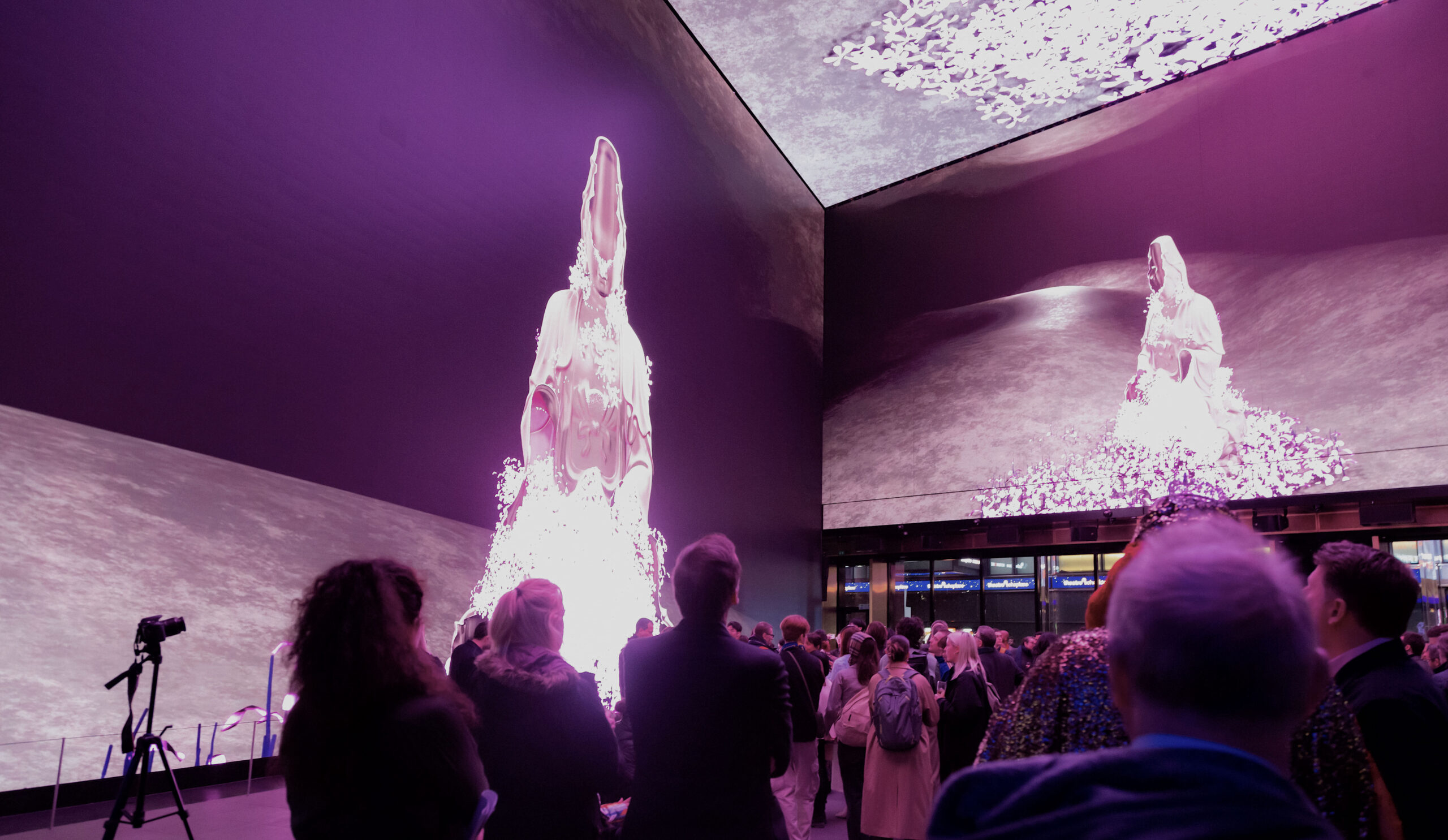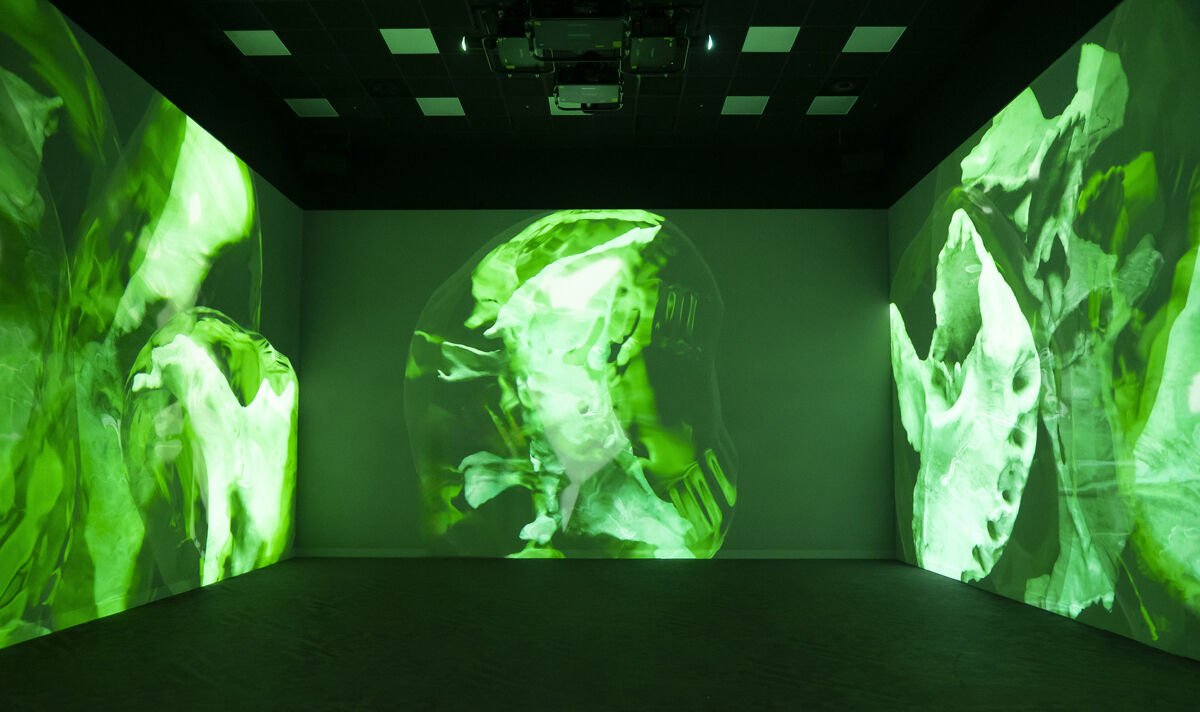

Tao Xie, a London-based digital artist, is forging new paths in the realm of contemporary art. His practice spans 3D visual storytelling, virtual reality, mixed reality and immersive experience, and it is defined by his ability to address profound societal and philosophical themes through cutting-edge digital media. Drawing from his cultural heritage and philosophical beliefs, Tao attempts to construct new modes of digital storytelling. His work delves deeply into identity, mental health, social behavior, and cultural contradictions, with a particular focus on bridging Buddhist philosophy and modern artistic expression.
Graduating from the Royal College of Art, his narrative explorations have brought a deeper philosophical perspective and multidimensional approach to his work. One of Tao’s most compelling strengths lies in his capacity to fuse technical innovation with narrative depth. His works are not merely visually arresting; they invite introspection and provoke dialogue on issues often left unexplored in the digital art space. Whether tackling environmental concerns, reinterpreting religious philosophy, or examining the complexities of self-perception, his art resonates on both intellectual and emotional levels.
Rethinking the Pure Land: The Land of Utmost Badness
In The Land of Utmost Badness, Tao Xie reimagines the Buddhist concept of the Pure Land as an “inverted utopia,” using it as a metaphor to explore mental health. The 3D short film combines Tao’s philosophical reflections with his personal experiences, creating a world where serenity and chaos coexist. This imaginative reinterpretation of Buddhist themes offers a poignant commentary on the fragility of the human psyche.
Tao shares, “This work is inspired by my personal experiences and observations of those around me. Mental health is a common issue, yet it’s often overlooked. I struggle with it myself, and many people I know also face similar challenges. I wanted to create a piece that raises awareness about the importance of mental health. I chose to express this topic through a Buddhist perspective because of my own identity as a Buddhist. I began learning about Buddhism in 2015, studying Tibetan and Pure Land Buddhism. I believe Buddhist philosophy offers a way of life and a practice for achieving mental stability, which is why I wanted to combine it with the theme of mental health.”
The film’s narrative draws from The Amitabha Sutra but subverts the traditional depiction of the Pure Land as a place of perfection. Instead, Tao presents a space riddled with psychological dissonance, mirroring the struggles of those grappling with mental health challenges. By flipping this traditional Buddhist metaphor, Tao creates a universal framework for viewers to reflect on their own emotional landscapes.
Visually, The Land of Utmost Badness is as captivating as it is thought-provoking. The intricate 3D environments and fragmented storytelling pull the audience into a world where beauty and discomfort collide.

Identity and Materiality: Sinner Prayer
Tao’s exploration of identity and societal perception is perhaps most evident in his work Sinner Prayer. Using unconventional materials such as incense ash and the ash from cigarette smoke, he constructs a visual metaphor that grapples with the tension between societal expectations and personal authenticity. These materials, charged with symbolic meaning, highlight the duality of purity and destruction.
As Tao explains, “The choice of incense ash and cigarette ash wasn’t random. Incense ash symbolizes spirituality and ritual, while cigarette ash represents destruction and transformation. Together, they embody the blurred lines between purity and imperfection, much like the dualities we experience in life.”
The work’s AR component extends this exploration into the digital realm, presenting two figures engaged in seemingly different activities yet representing the same individual. This duality underscores the fluid nature of identity, suggesting that people cannot be confined to singular definitions or fixed stereotypes. By juxtaposing materials and mediums, Tao reflects the layered complexity of human identity in a way that is both subtle and profound.
The work’s philosophical depth and its engagement with societal norms provoke a deeper consideration of how identity is shaped by both internal and external forces. Although the work’s symbolism is intricate, it risks alienating some viewers who may find its abstract approach to identity and societal judgment too elusive. Nevertheless, the conceptual richness of Sinner Prayer provides a profound reflection on the complexity of the self and the layers of meaning we assign to material forms.
Digital Art as a Platform for Environmental Awareness: The Circle Reveals
Beyond personal introspection, Tao Xie’s practice engages with global societal concerns. In The Circle Reveals, he examines the environmental impact of the NFT industry, exposing the hidden carbon footprint of blockchain technology. This VR project pairs research-driven insights with immersive storytelling, turning abstract data into an accessible and emotive experience.
Tao and his team set out to envision a system capable of achieving the cleanest possible NFTs—one that encourages audiences to think about how the digital world can coexist harmoniously with the physical environment. This concept is embodied in the creation of the “Cir-clean” system, inspired by the novel The Circular Ruins.
“We imagined Cir-clean as a system that could achieve the goal of the cleanest NFTs. The name ‘Cir-clean’ comes from combining the words ‘Circle’ and ‘Clean’—a direct nod to both the circular structure of the system and its aim to be environmentally sustainable,” Tao explains.
The project reimagines how new technologies could work alongside traditional blockchain systems to optimize energy consumption and reduce digital pollution. In their fictional narrative, viewers experience how the system would work, including how NFTs could be optimized for minimal energy usage, leading to a carbon-neutral ideal. “We wanted to create this fictional Cir-clean system to express our imagination of how humans can play a pivotal role in building a more sustainable digital future,” Tao remarks.
Narrative as the Core of Digital Innovation
In Tao’s practice, storytelling is paramount. While many digital artists prioritize technical spectacle, Tao places narrative at the heart of his creations. His works are deeply rooted in the belief that technology should serve as a tool to enhance storytelling, not overshadow it. This philosophy is evident in his preference for chapter-based, non-linear narratives, which encourage viewers to engage with his work on multiple levels.
Tao’s storytelling methods often involve breaking and reassembling conventional structures, creating a dynamic interplay of conflict and resolution. This approach invites the audience to become active participants in the narrative, rather than passive observers. By prioritizing narrative clarity and emotional resonance, Tao ensures that his works transcend their medium, offering insights that linger long after the experience ends.

Shaping the Future of Storytelling
Looking towards the future, Tao Xie reflects on the evolving potential of digital art: “Art should connect with people on multiple levels. It’s not just about the visual or technical aspects—it’s about telling stories that matter.” This forward-thinking approach has allowed Tao to push the boundaries of digital art, combining technical mastery, philosophical depth, and social engagement into a cohesive body of work.
Through his thoughtful exploration of complex themes, Tao has established himself as a leader in digital art, creating pieces that are not only innovative in form but also intellectually and emotionally impactful. His work challenges both the medium and the viewer, demonstrating that digital art, when driven by strong narrative and social relevance, can be as profound as any traditional art form.
The post Tao Xie: Redefining Digital Art through Narrative and Philosophy appeared first on Our Culture.






